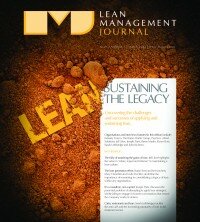By Paul Hardiman
One of the most common errors in lean implementation is for the organisation to “close out” the programme with the mistaken belief that lean has been achieved. In practice, sustaining a given level of leanness without continued focus is an impossible strategy and the most likely outcome is a progressive decline rather than resting on a plateau. Equally, it is well known that the Toyota approach is to assume that the lean journey is never over – there is always more to achieve by developing the programme in various ways.
Similarly, it is a mistake to think that the lean approach has dated and that firms must seek improved competitiveness by implementing alternative tools and programmes. Academic research published last year suggested that in the UK economy as a whole since 2008 there has been a significant increase in pressure on the individual to work harder while training on teamwork and problem solving has declined. So ideas such as continual improvement linked to standardised work developed through effective teamwork still have a long way to go in our economy.
At the end of a successful lean project (possibly using outside expertise) it is natural that employees will ask what next? The answer is to recognise that lean is a journey and the journey needs to include culture change. People at all levels need to adopt the right outlook and toolset. Research by McKinsey suggests that it is this ability to sustain the approach throughout an organisation, which could be an important differentiator between advanced economies and fast growing emerging manufacturing economies like China.
Generally the lean approach is still to make significant headway in service sectors and functions and it is no surprise that in general the rate of productivity growth in the UK service economy continues to be lower than the annual rates manufacturing now takes for granted. It is also important to understand that, particularly in the United States, the lean vision has been successfully extended to new areas such as lean start-up and lean software development.
New initiatives do not need to compete with lean. For example, total productive maintenance (TPM), which has great potential to raise the productivity of capital assets, should be built on a lean foundation. This approach will become even more important as advanced manufacturing spreads in the UK making manufacturing even more capital-intensive. Many new “headings” such as high performance working (HPW) turn out on examination to be extensions of key themes of lean. In the case of HPW it is through alignment with HR.
It has long been recognised that sustainability will only be achieved by culture change. However, what this means in practice continues to be a major area of research in leading US business schools. We know that culture change is closely tied up with leadership – not just at the top but all the way down the organisation. Effective leaders tend to accept that their leadership capability is not a matter of sustaining a plateau but also involves continual self- improvement too.

